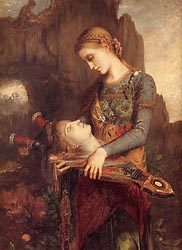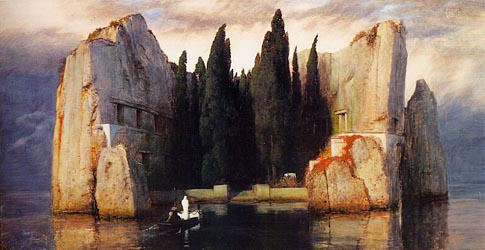|
John Henry Fuseli (1741-1825)
~ Born in Zürich,
in 1779 Fuseli immigrated to Britain . His extensive oeuvre dealt
with mythological and supernatural themes.
Francisco Goya y Lucientes (1746-1828) ~ The renowned painter of
the Spanish Court, Goya became deaf in 1792 as a result of a high
fever. His subsequent work turned eccentric and introspective.
%201821-23%201ac.jpg)
William Blake (1757-1827) ~ British
visionary illustrator, whose work with Biblical and Mythological
themes exhibited great originality and rejection of Christian orthodoxy.
Caspar David Friedrich (1774-1840) ~
A German landscape artist, who used barren trees, morning mist,
silhouetted figures and Gothic ruins to explore themes of mysticism
.
George
Frederic Watts (1817-1904) ~ British classical painter known for
many allegorical works, and for his influence on Dante Rossetti .
Theodore Chasseriau (1819-1856)
~ As a student of
Delacroix, he explored many mythological themes in addition to his
prevalent use of the Orientalist genre.
Pierre Puvis de Chavannes
(1824-1898) ~ Student of Chasseriau, one of the three important
artist of French Symbolism . Most of his major works were done as
murals. But they were in fact oil on canvas, then attached to a wall
.
Gustav Moreau (1826-1898) ~ Moreau produced
an
impressive
body of work with mythological and Biblical themes. In his various
paintings of Salome, he
promoted the theme of the femme-fatale, an important Symbolist
motif. He is considered one of the most influential of all
predecessors. A master of techniques, his style ranges from polished classical illusionism to
dreamy watercolors. The unusual work Tattoed Salome (1874)
incorporated primitive symbols carved into the painted surface. His
work is original and evocative, with genuine antiquated qualities.
Arnold Böcklin
(1827-1901)
~ Although born in the generation preceding the majority of
Symbolist artists, many of
Böcklin's
important paintings were in fact completed at the dawn of the age of
Symbolism .

Dante Rossetti (1828-1882) ~ He was one of the
founders of the Pre-Raphaelite Brotherhood, yet his art only became
broadly known after his death at the dawn of the Symbolist era . The broodiness of his art was
identified with within Symbolist circles.
Sir Edward Coley Burne-Jones (1833-1898)
~ Symbolist artists felt an affinity with the archaic qualities of
Burne-Jones' work. He enjoyed an immense reputation, considered to
be one of Europe's
most important artists at the end of the 19th Century, during the
age of Symbolism .
|